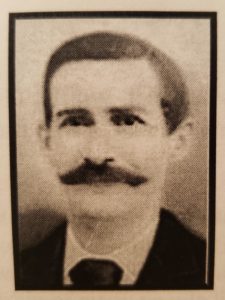Submitted by Sid Stroupe and Mike Stroupe; Written and vetted by Cheri Todd Molter
(Click photo to enlarge)
On July 30, 1861, Moses Stroup Jr. was twenty-two and lived in Gaston County, southeast of White Pine, which is currently Cherryville, NC, when he enlisted with the Confederate army for one year. He re-enlisted with the Confederate army for a two-year term in March 1862 and was paid $50.00 for it. He was a Private in Company B of the 28th Infantry Regiment, North Carolina.
On the 27th or 28th of May 1862, he was captured by the Union Army at Hanover Court House. Moses was described as 5’8” tall with dark eyes, hair, and complexion. He was confined as a prisoner of war at Fort Monroe, Virginia and later moved to Fort Columbus, New York. Ultimately, he was transferred to Aiken’s Landing, along the James River in Virginia, where he was presented to the Confederate army in a prisoner exchange on Aug. 5, 1862.
In December of 1862, Moses was captured again in Fredericksburg, Virginia. He was paroled on December 17, 1862 and returned to service on March 1, 1863. According to military records, by the end of February of the following year, he was “present” with his company but had been “absent without leave.” There was a note added that stated: “Stoppage one-month’s pay of $11.00.”
On his Veterans Pension Application, Moses stated that just prior to Gettysburg, on or about May 3, 1863, his right foot was wounded. His wound was determined to be non-life-threatening, so he stayed with his company and was at the Battle of Gettysburg in early July 1863. He was captured there and hospitalized at the U.S.A. General Hospital in Chester, Pennsylvania.
Moses returned, for the third time, to active duty. On May 12, 1864, at the Battle of Spotsylvania in Virginia, Moses was captured again by Union forces. He was confined at Point Lookout, Maryland, shortly after he had been captured, then transferred to Elmira, NY, on August 8, 1864. He was held for nearly 10 months at that prison, commonly referred to as “Camp Hellmira” due to the “hellish” conditions prisoners endured there. He was released after pledging the Oath of Allegiance to the United States of America on June 19, 1865.
After the war, Moses returned to his home and land of substantial acreage, near the Tryon School area of Gaston County (southeast of present-day Cherryville). On Dec. 21, 1865, Moses married Sarah Ann Carpenter in Gaston County. Moses and Sarah had seven children: Laura (1866), Andrew (1868), Margaret (1870), Ida (1873), Elizabeth (1875), Mary Luola (1878), and Lillian (1881).
Unfortunately, Sarah died in October of 1881; their youngest daughter was only about 9 months old at the time. After Sarah’s death, Moses married Susan C. Hovis, and they had three children together: David (1885), Mabel (1886), and Zona (1888). Moses was a well-known citizen throughout Gaston County: He served Gaston County as Representative to the NC House during the 1891 Session of the North Carolina State Assembly.
On June 30, 1911, Moses filed a Civil War NC Soldiers Application for Pension. It was disallowed because his “personal wealth exceeded the maximum allowed ($500.00).” On his application, Moses stated that his wealth was estimated at $10,000.
Moses Stroup Jr. died in 1920 and was buried at Concord Methodist Church Cemetery, which is in Gaston County, NC.

